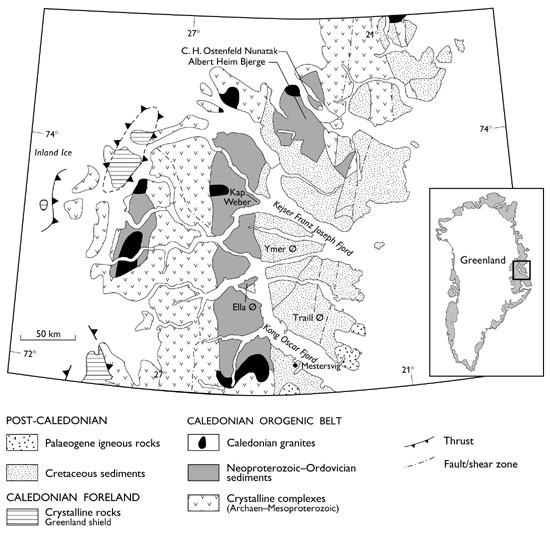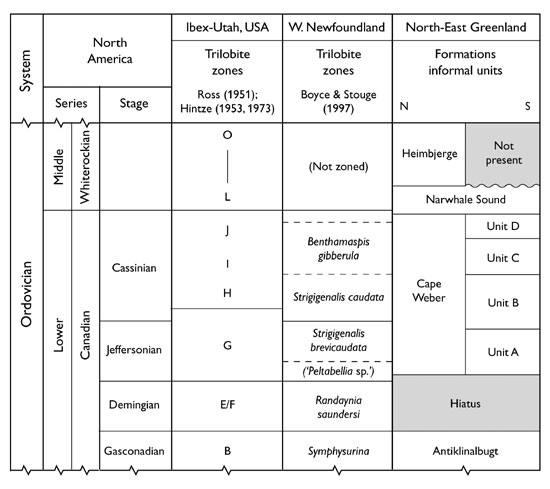
The Ordovician succession of North–East Greenland: stratigraphy and significance
Svend Stouge1, W. Douglas Boyce2, Jørgen Christiansen3, David A.T. Harper and Ian Knight2
1 Geological Survey of Denmark and Greenland, Øster Voldgade 10, Dk–1350 Copenhagen K, Denmark. E–mail: ss@geus.dk
2 Government of Newfoundland and Labrador, Mines and Energy, Geological Survey Division, Regional Geology Section, P.O. Box 8700, St. John’s, Newfoundland, Canada A1B 4J6.
3 Holbaek College of Education, Seminarieparken 2, DK–4300 Holbæk, Denmark.
4 Geological Museum, Øster Voldgade 5–7, DK–1350 Copenhagen K, Denmark.
Key words: Platform sediments. Stratigraphy. Iapetus margin. Ordovician. North-East Greenland.
Introduction
Ordovician exposures occur in an N–S trending outcrop area along the fjord region in North–East Greenland (Figure 1). The outcrop area is composed of Neoproterozoic – Ordovician sediments. The Ordovician strata consist of nearly 3000 m of carbonates, which are prominently exposed on Ella Ø, in Albert Heim Bjerge and on C.H. Nunatak (Figure 1). The Ordovician succession is overlain unconformably by Devonian fluviatile and lacustrine clastic sediments.
Ordovician stratigraphy
The Ordovician strata are referred to the Antiklinalbugt, Cape Weber, Narwhale Sound and Heimbjerge formations (Poulsen, 1930, 1937; Cowie and Adams, 1957; Peel and Cowie, 1979). Revisions to this scheme are in preparation (Stouge et al., 2001, 2002; Figure 2).
The Antiklinalbugt Formation consists of shallow water peritidal carbonates with abundant planar and domal stromatolites together with thrombolites. Subtidal siltstones, shales and thick beds of lime mudstones comprise the middle part and a thick–bedded lamellar dolostone marks the top of the formation.
The Antiklinalbugt Formation overlies the Upper Cambrian Dolomite Point Formation, which consists of mainly microcrystalline dolostones. The Cambro–Ordovician System boundary correlates with the formational boundary between the Dolomite Point and the Antiklinalbugt formations (Stouge et al., 2001).

Figure 1. Locality map of North–Eastern Greenland with simplified geology. The distribution of the Neoproterozoic – Ordovician outcrops are shown.
The trilobite fauna includes Hystricurus armatus and Symphysurina woosteri. Brachiopods and Sinuopea whittardi are present. Cordylodus intermedius, C. angulatus and Rossodus manitouensis are the characteristic conodonts (Smith, 1991; Smith and Bjerreskov, 1994; Huselbee, 1998; Stouge et al. 2001). The formation is Gasconadian in age (Symphysurina and Bellefontia–Xenopstegium zones; Lower Ordovician) (Stouge et al., 2001; Figure 2).
The overlying Cape Weber Formation (the name derives from Kap Weber; Figure 1) is 1140 m thick; it is subdivided into four informal units (Figure 2, units A–D).
Unit A consists of metre–thick carbonate beds with domal and flat stromatolitic mounds and thrombolites. Unit B consists of peritidal cycles of well–bedded bioturbated limestone, thrombolitic mounds and abundant stratabound and brown–weathering chert nodules. Thick–bedded packstones to grainstones associated with mounds and nodular chert characterise unit C and unit D is a grey and dark grey lime mudstone with several chert horizons. Unit D also includes a unit known as the ‘Black Limestone’ at Albert Heim Bjerge (Cowie and Adams, 1957).

Figure 2. The Ordovician stratigraphy of North–East Greenland compared to trilobite zones of Utah, USA and western Newfoundland, Canada. Modified from Stouge et al., 2002.
The fauna comprises trilobites, cephalopods, brachiopods and ostracodes. Rich and diverse benthic faunal assemblages are associated with the chert horizons. The cosmopolitan trilobite genus Carolinites is recorded from the ‘Black Limestone’ (Cowie and Adams, 1957). Unit A yielded Fauna D conodonts and the Oepikodus communis Zone is recognized from units B, C and D (Smith, 1991; Smith and Bjerreskov, 1994). The formation is late Jeffersonian and Cassinian in age (Lower Ordovician) and the trilobite zones Strigigenalis brevicaudata to Benthamaspis gibberula are recognised (Figure 2).
The Cape Weber Formation disconformably overlies the Antiklinalbugt Formation and the corresponding hiatus covers the Demingian and early Jeffersonian (Stouge et al., 2001, 2002; Figure 2).
The Narwhale Sound Formation consists of sucrosic and laminated dolostones, interbedded bioturbated limestones and dolostones and small thrombolitic mounds. The formation spans the Lower – Middle Ordovician series boundary (Stouge, 1978; Smith, 1991; Smith and Bjerreskov, 1994).
The Heimbjerge Formation is preserved in the northern part of the exposed area (Figures 1, 2). It starts with peritidal cycles succeeded upwards by well–bedded lime mudstones and clean wackestones associated with stromatoporoid mounds. The formation is 1200 m thick on C.H. Ostenfeld Nunatak (Frykman, 1979; Figures 1, 2). The Heimbjerge Formation is Whiterock in age.
The western margin of the Iapetus Ocean
Swett and Smit (1972) found that the Cambro–Ordovician platformal succession extending from Western Newfoundland, North–West Scotland to North–East Greenland show similar development.
The similar development between these areas becomes less obvious when the following differences are considered: 1) the early Ordovician hiatus recorded from North–East Greenland is unique; in eastern North Greenland it covers the Cambrian and early Ordovician (Higgins et al., 1991). This suggests that uplift, probably an early Caledonian event, occurred at that time at the northeastern corner of Laurentia. A similar hiatus has not been observed in Western Newfoundland (Boyce, 1989; Boyce and Stouge, 1997) nor is it known from North–West Scotland. 2) The deposition of Whiterock shallow marine carbonates in North–East Greenland shows that tectonic stability prevailed in the region. In Western Newfoundland a foreland basin evolved due to the collision of the Peri–Laurentian Arc with Laurentia.
Conclusions
The Ordovician strata of North–East Greenland accumulated during three major depositional cycles. The Gasconadian Antiklinalbugt Formation represents the first cycle. The second cycle starts with the Cape Weber Formation and concludes with the peritidal facies of the Narwhale Sound Formation and the third depositional cycle comprises the Heimbjerge Formation (Whiterock).
Comparison of the Ordovician succession of near–adjacent areas along the Iapetus margin of Laurentia, i.e., from eastern North Greenland to Western Newfoundland shows that 1) the evidence for similar depositional and the tectonically development is not as conclusive as previously accepted and 2) the Ordovician succession in North–East Greenland provides important constraints on the extent of the Taconic Orogeny.
References
Boyce, W.D. 1989. Early Ordovician trilobite faunas of the Boat Harbour and Catoche formations (St. George Group) in the Boat Harbour–Cape Norman area, Great northern Peninsula, western Newfoundland. Newfoundland Department of Mines and Energy, Geological Survey Branch, Report, 89–3: 1–169.
Boyce, W.D. and Stouge, S. 1997. Trilobite and conodont biostratigraphy of the St. George Group, Eddies Cove West area, western Newfoundland. Current Research (1997), Newfoundland Department of Mines and Energy, Geological Survey, Report, 91–1: 183–200.
Cowie, J.W. and Adams, P.J. 1957. The geology of the Cambro–Ordovician rocks of Central East Greenland. Pt. I. Stratigraphy and Structure. Meddelelser om Grønland, 153 (1): 1–193.
Frykman, P. 1979. Cambro–Ordovician rocks of C.H. Ostenfeld Nunatak, northern East Greenland. Rapport Gronlands Geologiske Undersøgelse, 91: 125–132.
Higgins, A.K., Ineson, J.R., Peel, J.S., Surlyk, F. and Sonderholm, M. 1991. Lower Palaeozoic Franklinian Basin of North Greenland. Gronlands Geologiske Undersøgelse Bulletin, 160: 71–140.
Huselbee, M.Y. 1998. Late Cambrian to earliest Ordovician (Ibexian) conodont evolution and biogeography of Greenland and northwest Scotland. Unpublished Ph.D. thesis, University of Birmingham: 299.
Peel, J.S. and Cowie, J.W. 1979. New names for Ordovician formations in Greenland. Rapport Grønlands Geologiske Undersøgelse, 91: 117–124.
Poulsen, C. 1930. Contributions to the stratigraphy of the Cambro–Ordovician of East Greenland. Meddelelser om Grønland, 74 (12): 297–316.
Poulsen, C. 1937. On the Lower Ordovician faunas of East Greenland. Meddelelser om Grønland, 119 (3): 1–72.
Smith, M.P. 1991. Early Ordovician conodonts of East and North Greenland. Meddelelser om Grønland Geoscience, 26: 1–81.
Smith, M.P. and Bjerreskov, M. 1994. The Ordovician System in Greenland. Correlation chart and stratigraphic lexicon. International Union of Geological Sciences Special Publication 29A: 46.
Stouge, S., Boyce, D.W., Christiansen, J., Harper, D.A.T. and Knight, I. 2001. Vendian – Lower Ordovician stratigraphy of Ella Ø, North–East Greenland: new investigations. Geology of Greenland Survey Bulletin, 189: 107–114.
Stouge, S. 1978. Upper Canadian (Lower Ordovician) conodonts from central East–Greenland. Geological Association of Canada, Mineralogical Association of Canada. Geological Society of America Joint Annual Meeting 1978. Abstracts with programs, 3: 499.
Stouge, S. Boyce, D.W., Christiansen, J., Harper, D.A.T. and Knight, I., 2002. Lower–Middle Ordovician stratigraphy of North–East Greenland. Geology of Greenland Survey Bulletin, 191: 117–125.
Received: February 15, 2003
Accepted: June 15, 2003